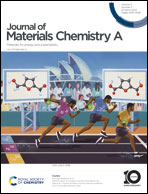Manipulation of chemical behavior of species by a temperature-program strategy: efficiently confining metal oxide nanoclusters in a hollow zeolite†
Abstract
Currently, the development of a green strategy based on novel confinement theory to guide the limitation of metal particles encapsulated in zeolite to nano-size at a high amount of metal loading is of great significance, to achieve higher utilization of metal atoms in catalysis. Here, we designed a novel methodology to construct hollow silicate-1 encapsulating ultra-small monometallic (Fe2O3: 1.37 nm, CuO: 2.97 nm) and bimetallic oxide (Fe2O3–CuO: 2.61 nm, Fe2O3–CoOx: 2.16 nm, Fe2O3–PtOx: 3.63 nm) nanoclusters (with a loading exceeding 2 wt%) via mother-liquor-induced temperature-programmed post-treatment. This was based on the various chemical behaviors among species stimulated by different temperature intervals in the post-synthesis zeolite system containing metal heteroatoms, including the single dissolution behavior of zeolite, condensation between silicon species and the capture of metal atoms by unsaturated silicon species. Experiments confirmed that these unique chemical behaviors are dominant in different temperature intervals, and density functional theory confirmed the reasonableness of the theory. Thus, an optimal temperature program was determined to directionally modulate the chemical behaviors of species in post-treatment, enriching the unsaturated silicon species in the liquid phase, reinforcing the orientated capture of metal hydroxyl in metal oxide particles, eventually accelerating the insertion of metal into the framework and the disintegration of metal oxide particles into ultra-small nanoclusters encapsulated in cavities. The metal oxide nanocluster size is negatively related to the capacity of unsaturated silicon species to capture metals. Notably, the short diffusion pathway, high utilization of active sites, and synergistic effect between bimetals endowed Fe2O3–CuO@HS-1 with superior activity and stability for degradation reactions.



 Please wait while we load your content...
Please wait while we load your content...